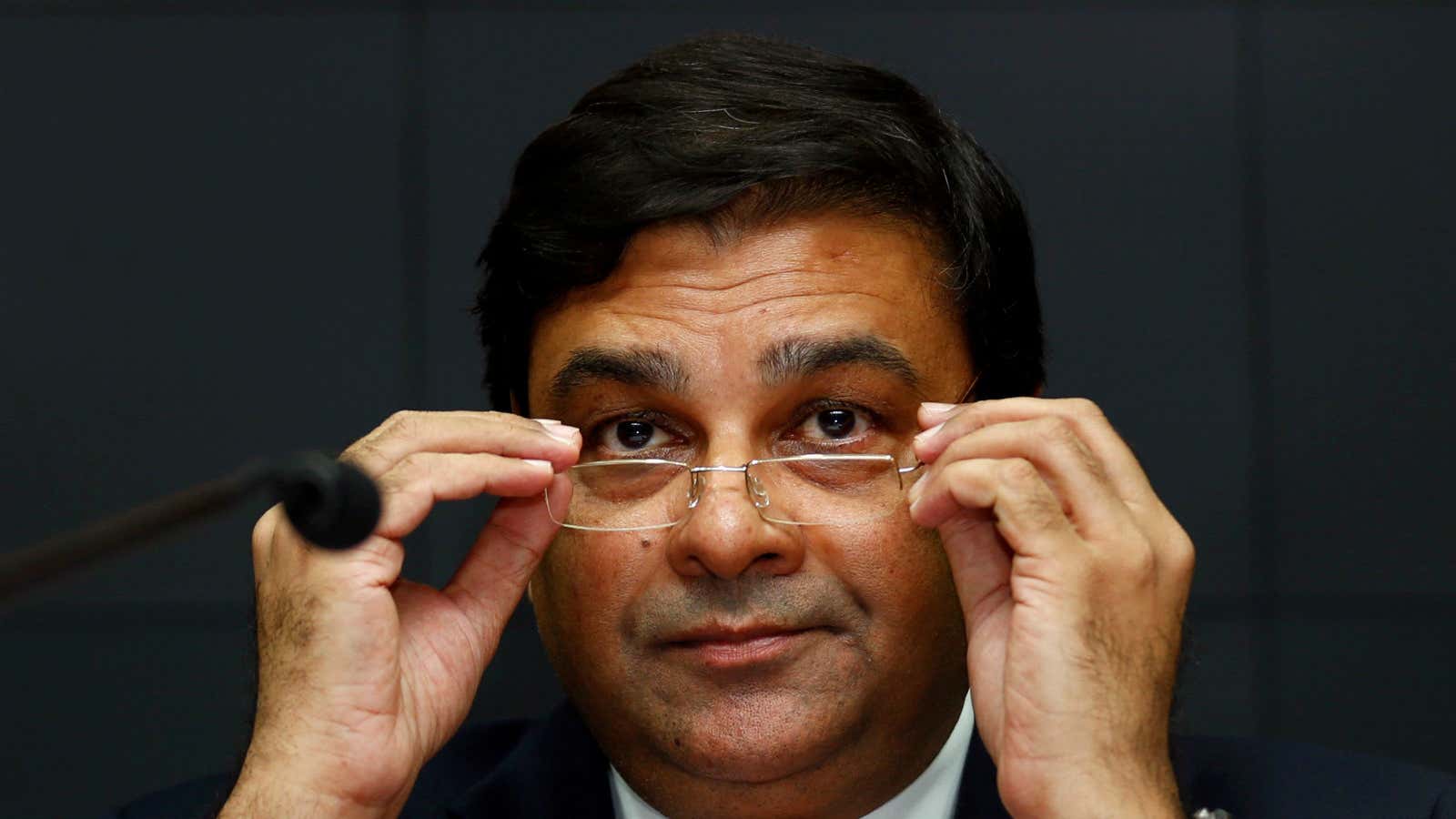Four months ago, when Urjit Patel took charge as the 24th governor of the Reserve Bank of India (RBI), he had big shoes to fill. His predecessor, Raghuram Rajan, had proven to be a superstar with his free-flowing eloquence making an instant connect with Indians. Patel’s low-profile style of functioning was inevitably compared to that of Rajan’s.
In November, however, a whole new challenge was added to his governorship.
When prime minister Narendra Modi banned the country’s two most popular notes on Nov. 08, Patel had been at the helm for just two months. Demonetisation put 1.3 billion Indians in a spot and this 52-year-old Yale and Oxford product was certainly one of them.
The new RBI governor was left to field a slew of criticism that ranged from a lack of involvement on his part in the massive process to the RBI’s inadequate co-ordination with the government. Hit by demonetisation, protesting Indians even waved black flags at him. A functionary of the All India Bank Officers Confederation, a union of some 2.5 lakh bank officials, called for Patel’s resignation in the wake of the havoc wreaked on the economy.
And that was just the beginning.
No involvement
The central bank is responsible for printing and circulating currency in India, except in the case of the Re1 note which is printed by the government of India. Many expected the RBI—and Patel himself—to be directly involved in the conceptualisation, planning, and execution of demonetisation.
However, when the prime minister addressed the nation on the evening of Nov. 08 to make the announcement, Patel was nowhere in sight.
“Patel had vanished from public sight during the early weeks of the demonetisation process, raising questions about his accountability and leadership as the central bank governor,” said Rajiv Biswas, Asia-Pacific chief economist at IHS Markit, a consultancy.
Between Nov. 08 and Nov. 24, Patel spoke only once in public. Modi, on the other hand, was on national television at least six times around that period.
“It is generally to be expected, and is typically the case, that the actual issuer of the currency, the central bank, plays the leading, if not the sole, role in these matters,” Robert Hockett, a professor at Cornell University and an advisor to the New York Federal Reserve, told Bloomberg.
What added to the confusion was the repeated reversal of and tweaks to policy, leaving the citizenry exasperated. The sheer number of RBI notifications—between Nov. 08 and Dec. 08 alone, it issued 50 of them—has been too much to handle. A Congress leader alleged that in 43 days, the RBI changed rules 126 times.
The general message that seemed to come from the RBI was one of utter confusion. For a national institution long perceived as a bastion of prudence and stability even amid large-scale political and economic unpredictability, the indecisiveness of the past two months has been reputation-ruining.
Predictably, India’s venerable central bank drew flak at home and abroad. It was subject to some amount of ridicule with some quipping that RBI stood for the “Reverse Bank of India.”
“Demonetisation has cast a shadow over the RBI’s competence and independence,” Kyran Curry, a director with credit ratings agency Standard & Poor’s told Reuters. Such doubts over the central bank’s independence can be devastating as future decisions, especially those pertaining to monetary policy, could be seen in the same light.
Is the criticism fair?
However, many point out that neither the RBI nor Patel had much to do with the demonetisation exercise. And with his low-profile demeanour, Patel has inadvertently been put in a difficult position.
“It is clear that demonetisation was the government’s call and so one should be careful about attributing credit or blame to the central bank,” explained Milan Vaishnav, senior associate in the South Asia program at Carnegie Endowment for International Peace.
“No doubt, part of Patel’s appeal is his understated demeanour. It is no secret the government felt strongly that his predecessor, Raghuram Rajan, spoke out of turn on far too many occasions. Patel is widely known to keep a low profile. To be fair, on this particular policy issue, the new governor and the RBI have been put in a tight spot,” Vaishnav added.
There is nothing wrong about the RBI or its governor remaining silent and not reiterating the government’s message, according to Charan Singh, visiting faculty at the Indian Institute of Management, Bangalore. “In view of any policy businesses that they may have amongst themselves should be sorted out in close door meetings and dirty linen should not be washed in public. Market sentiments and confidence are built when government and the RBI work together for national economic growth,” he said.
Meanwhile, Patel has a lot of firefighting left to do. For one, the governor will be under immense pressure to cut rates in the monetary policy review in February. He held rates stable in December, a month after demonetisation, despite hopes of lower rates to ease the pain on the economy.
With demonetisation destabilising the world’s fastest-growing large economy, a steady pair of hands will be an imperative at Mint Road. Can Patel deliver?
We welcome your comments at ideas.india@qz.com.
